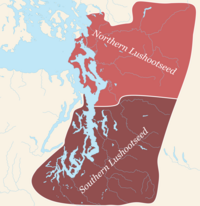Suquamish
Lushootseed | |
| Related ethnic groups | |
|---|---|
| Coast Salish, Nlaka'pamux, Bitterroot Salish |
The Suquamish (
Today, most Suquamish people are enrolled in the
Language and culture
Suquamish people traditionally speak a dialect of
Like many Northwest Coast indigenous peoples pre-European contact, the Suquamish enjoyed the rich bounty of land and sea west of the Cascade Mountains. They fished for salmon and harvested shellfish in local waters and Puget Sound. The cedar tree provided fiber used to weave waterproof clothing and beautiful utilitarian items, and provided wood for longhouses, seagoing canoes and ceremonial items.
The Suquamish traditionally lived on the western shores of Puget Sound, from
The Suquamish continue to fish and harvest in their traditional territory, and a new generation of local artists — among them Ed Carriere[5] — carry on the ways of their ancestors in creating carved or woven items that help tell the story of the Suquamish people.
In 2011, the Suquamish Tribal Council voted unanimously to
History
The first contact between Suquamish and European people came in 1792 when
Once the
Leaders and notable people
Two members of the Suquamish came to be recognized across the region as great leaders. One was
Martha George served as chairwoman of the Suquamish Tribe from the late 1920s to the early 1940s.[7]
Lawrence Webster (1899-1991) served as chairman of the Suquamish Tribe from 1979-1985. In 1979, he traveled to Washington, D.C., to represent Native Americans at an event commemorating the 15th anniversary of the government program, VISTA. In 1983, he helped establish the Suquamish Museum. Earlier in his life, he was a noted baseball catcher, playing on a Suquamish team in 1921 that was sent by a national sporting-goods company on a goodwill tour of Japan.[8]
Leonard Forsman, an anthropologist and archeologist who has served as the Suquamish Tribe’s chairman since 2005, is a governor-appointed member of the state Board on Geographic Names and an Obama appointee to the U.S. Advisory Council on Historic Preservation.[9]
Cindy Webster-Martinson, a former Suquamish Tribal Council member, is vice president of the North Kitsap School Board (elected in 2013 to a four-year term) and is believed to be the first Native American elected to non-Tribal public office in Kitsap County.[9] She is a granddaughter of Lawrence Webster.
Governance
The
Economy
Port Madison Enterprises, the Tribe’s economic development arm, is the second-largest private-sector employer in Kitsap County with 752 employees, surpassed only by Harrison Medical Center.[10]
Port Madison Enterprises is governed by a seven-member board of directors, which includes a Tribal Council liaison. Notable ventures include the Suquamish Clearwater Casino Resort, White Horse Golf Club, Kiana Lodge, PME Retail, and Property Management. Ongoing subsidiaries include the Port Madison Enterprises Construction Corporation.
Economic contributions (in 2012): $52.2 million in wages and benefits paid to employees; $46.8 million in goods and services purchased; $18.6 million in capital project investment. Community contributions (in 2012): $694,033 awarded to 201 organizations.[9]
The PME Fund sets aside non-gaming funds for distribution as grants to organizations that "[improve] the lives of community members" and "support worthy programs in the region".
Reservation
The Tribe has reacquired land lost during the allotment era, and "the Tribe and Tribal members now own more than half of the land on the reservation for the first time in recent history".[9] Major acquisitions include White Horse Golf Club in 2010, placed into trust in March 2014; and 200 acres known as the Place of the Bear, in the Cowling Creek watershed, in November 2014.
As of 2014, the reservation area consists of 7,657 acres, of which 1,475 acres are owned by the Suquamish Tribe, 2,601 acres are owned by individual citizens of the Suquamish Tribe, and 3,581 acres are owned by non-Natives.[9]
References
- ^ "Lushootseed Dictionary Online".
- ^ a b Suquamish.nsn.us
- ^ "Old Man House Collections Come Home (press release)". Burke Museum. October 24, 2013. Retrieved December 2, 2015.
- ISBN 0-385-01875-4.
- ^ Burkemuseum.org
- ^ Yardley, William (August 12, 2011). "A Washington State Indian Tribe Approves Same-Sex Marriage". The New York Times. Retrieved August 12, 2011.
- ^ "Notable Native American Women". Retrieved April 20, 2013.
- ^ Seattle Times
- ^ a b c d e Walker, Richard (January 30, 2015). "Suquamish Tribe's economic boom 'breathtaking'". North Kitsap Herald.
- ^ Kitsapeda.org
External links
- Suquamish Tribe (Port Madison Indian Reservation) homepage
- Suquamish Museum
- Tulalip Tribes v. Suquamish Indian Tribe, 794 F.3d 1129 (9th Cir. 2015) — decision of the U.S. Court of Appeals for the Ninth Circuitin a treaty fishing rights case

